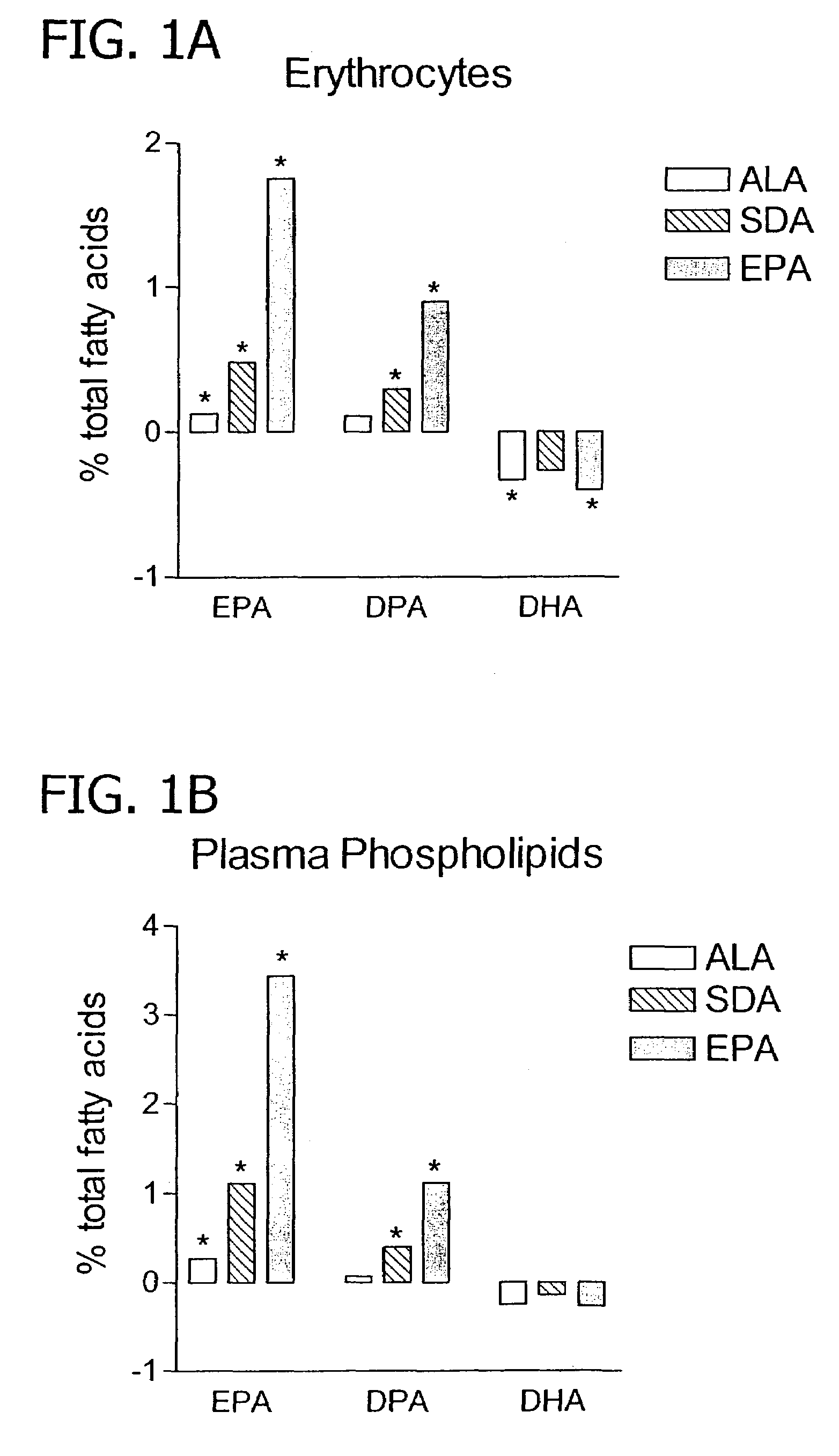Treatment and prevention of inflammatory disorders
a technology for inflammatory disorders and treatment, applied in the direction of immunological disorders, antibacterial agents, drug compositions, etc., can solve the problems of autoimmune diseases, significant damage through exerted actions, and failure of organs such as kidneys, liver, heart, and lungs
- Summary
- Abstract
- Description
- Claims
- Application Information
AI Technical Summary
Benefits of technology
Problems solved by technology
Method used
Image
Examples
example 1
Subjects and Methods
[0082]45 males and post-menopausal female—19–65 years of age, normolipidemic, and with a body mass index (BMI) in the range 20 to 30, were recruited. Exclusion criteria included bleeding disorders, hypertension, inflammatory disorders, active gastrointestinal diseases, chronic use of low dose aspirin, consumption of restaurant or takeaway evening meals more than twice per week, use of dietary supplements rich in n-3 or n-6 fatty acids, habitual consumption of more than 1 fish meal per month, and plasma phospholipid EPA+DHA levels>7.9% of total fatty acids (level achieved in the study group was 4.9±1.0% of total fatty acids).
[0083]Subjects were randomly allocated to one of three groups, designated ALA, SDA, and EPA.
[0084]A. Study Design
[0085]Following a 3-week run-in period, subjects ingested either ALA, SDA, EPA supplied as ethyl esters in capsules. Intakes were 0.75 g / day for 3 weeks followed by 1.5 g / day for the subsequent 3 weeks.
[0086]
TABLE 1Study DesignWeeks...
example 2
Results
[0102]There was no statistically significant difference in baseline BMI between the groups (Table 1). Subjects were weighed at each visit and there was no significant change in weight during the trial.
[0103]
TABLE 2BMIValueDietary Group(Kg / m2)EPA (25.6 ± 3.01 SDA26.2 ± 3.8ALA27.5 ± 2.91mean ± SD
[0104]Summary data for energy and macronutrient intake are shown in Table 2. There was no significant difference in energy or macronutrient intake between any group at baseline (Diet Record period 1). There were no statistically significant changes in energy or macronutrient intake during the study (i.e. Diet Record periods 1 to 3) in any group.
[0105]
TABLE 3Energy and Macronutrient Intake estimated from weighed food records.Diet Record Period1Group123Energy MJEPA 8.99 ± 1.9129.45 ± 1.919.34 ± 1.98[Kcal][2161][2272][2245]SDA8.97 ± 2.089.12 ± 2.489.26 ± 21.4[2157][2192][2226]ALA8.80 ± 1.299.06 ± 2.048.77 ± 1.71[2114][2178][2107]Protein gEPA99 ± 23107 ± 22 101 ± 23[% en][18.2][18.4][17.7]...
example 3
Clinical Study of the Effectiveness of SDA on Down-Regulating C-Reactive Protein
[0125]Approximately 35–50 males and post-menopausal female -19–65 years of age, normolipidemic, and with a body mass index (BMI) in the range 20 to 30, are recruited. Exclusion criteria include bleeding disorders, hypertension, inflammatory disorders, active gastrointestinal diseases, chronic use of low dose aspirin, consumption of restaurant or takeaway evening meals more than twice per week, use of dietary supplements rich in n-3 or n-6 fatty acids, habitual consumption of more than 1 fish meal per month, and plasma phospholipid EPA+DHA levels>7.9% of total fatty acids. Subjects are randomly allocated to one of three groups, designated ALA, SDA, and EPA.
[0126]A. Study Design
[0127]Following a 3-week run-in period, subjects ingest either ALA, SDA, EPA supplied as ethyl esters in capsules. Intakes are approximately 0.75 g / day for 3 weeks followed by 1.5 g / day for the subsequent 3 weeks. At each visit, blo...
PUM
| Property | Measurement | Unit |
|---|---|---|
| thickness | aaaaa | aaaaa |
| thickness | aaaaa | aaaaa |
| TNF-α | aaaaa | aaaaa |
Abstract
Description
Claims
Application Information
 Login to View More
Login to View More - R&D
- Intellectual Property
- Life Sciences
- Materials
- Tech Scout
- Unparalleled Data Quality
- Higher Quality Content
- 60% Fewer Hallucinations
Browse by: Latest US Patents, China's latest patents, Technical Efficacy Thesaurus, Application Domain, Technology Topic, Popular Technical Reports.
© 2025 PatSnap. All rights reserved.Legal|Privacy policy|Modern Slavery Act Transparency Statement|Sitemap|About US| Contact US: help@patsnap.com

